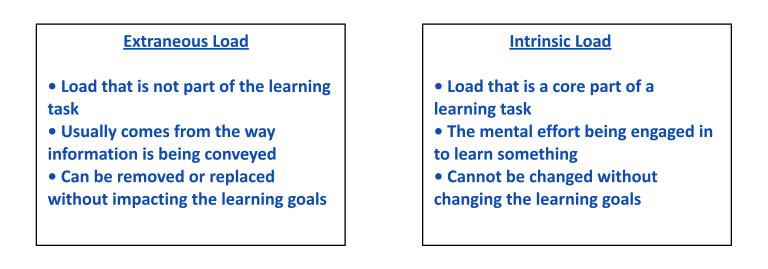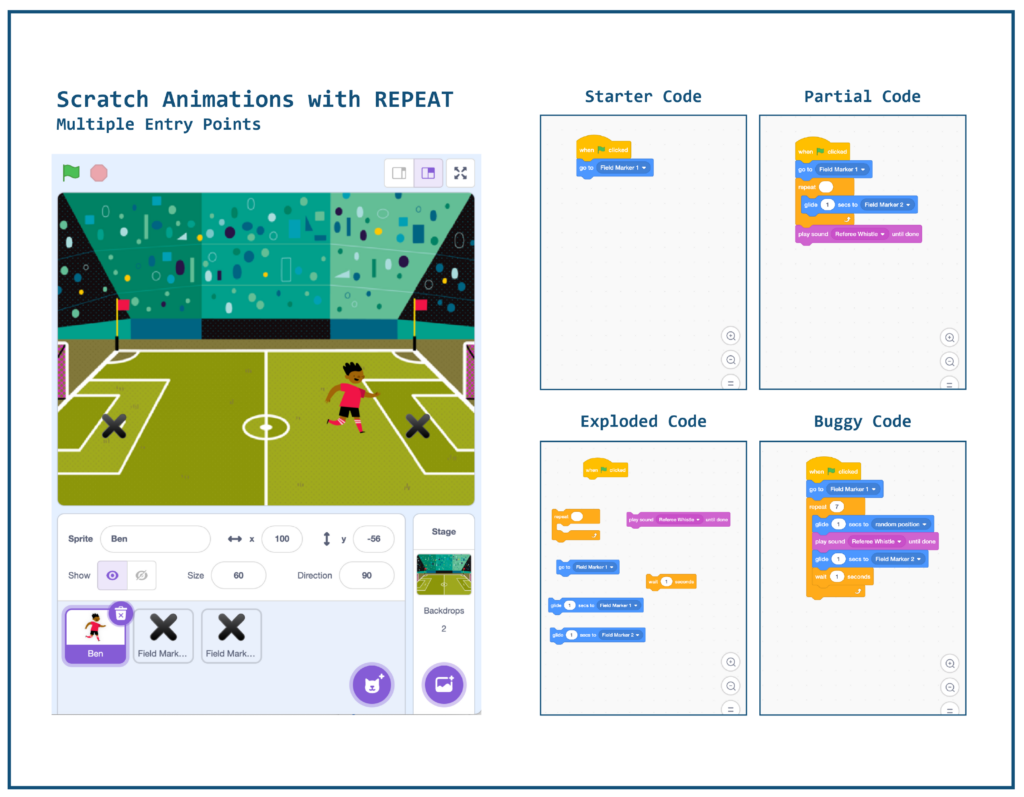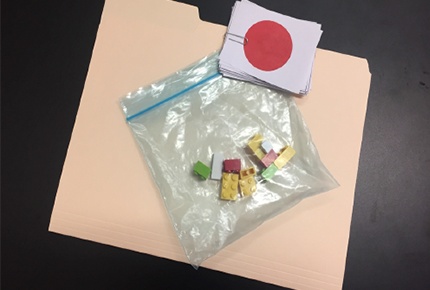Considering Cognitive Load in Computational Thinking Teaching and Learning
By Tara Robillard
How does the brain process information?
First, let’s talk about how our brain processes information. When we are learning something new, we are usually taking in information with our senses (think audio, visual, and tactile) and the goal is to eventually commit some or all the information to long term memory so that we can “call on it” when we need to demonstrate or use what we’ve learned. The truth is that when we are learning new information, only “bits and pieces” of it make it into our cognitive working space. There is very limited processing capacity and space there to begin with and the processing going on there is impacted by our executive functions (think attention, overall mental state, and motivation). For most learners, working memory or short-term memory is the major bottleneck when it comes to processing information.
What is Cognitive Load Theory?
Cognitive Load Theory (CLT), even though it sounds a little scary, gives us a framework for figuring out what might be getting in the way of the learning by overwhelming a learner’s working memory capacity (Sweller, 2010). Let’s focus on two of the three cognitive loads in CLT – Extraneous and Intrinsic Load.

So, the best-case scenario for learning is to be sure that cognitive load doesn’t exceed the capacity of working memory. We can do this by making sure that for whatever learning experience students are engaged in – that the extraneous loads are low, and the intrinsic loads match the ability level of the learner.
Applying Science to Enhance Learning: Skills and Strategies
Now that we know a little bit about cognitive load theory, let’s think about how we can apply it to the way we design and deliver learning experiences for students, especially those with executive function challenges. Here we will dive into a few suggestions in two key areas: reducing extraneous cognitive load and managing intrinsic load. We will illustrate these considerations and strategies with examples from INFACT activities.
Strategy 1: Reduce Extraneous Cognitive Load
By finding ways to reduce extraneous cognitive load we ensure that students can utilize as much of their cognitive processing capacity as possible to deal with what they are really supposed to be doing or learning. One of the ways that we do this in INFACT activities is to provide options for ways to engage in/with an activity.
For example, In the Make Your Own Zoombini Activity students can choose to do the activity online using a “Google Slides” version of the activity instead of having to use hands on materials (that require fine motor skills).

In the Barrier Game: Building-Bricks Challenge activity, we provide a set of a set of optional “Picture Cards” so students that are English language learners, non-verbal, have language deficits, trouble expressing their ideas verbally, and/or prefer to use visuals, can use the cards to give or receive commands required in the game.
Strategy 2: Manage Intrinsic Cognitive Load
Sometimes it isn’t possible to eliminate or reduce the extraneous load enough to make the task or activity manageable. When this is the case, one option is to manage the intrinsic load by reducing the complexity of the task or activity to make it more manageable for the learner. We included scaffolds and options in INFACT activities to give learners the option to make the task more manageable.
In the Language Commands Sort activity, the goal is to solidify understanding of clear commands by sorting commands and “programs” in different languages, grouping ones that mean the same thing. For this activity, we provide several different “sub-sets” of cards for teachers and learners to choose from to adjust the complexity of the task.

For Scratch programming activities, we integrated the strategy of creating programming activities with multiple-entry points to give students a choice of how to engage in computing in different ways with different levels of participation (Grover, 2020). These include a set pre-made programs that include: a “starter” code that helps students get started by providing the first few steps; an “exploded” code that students can put into the correct order; a “partial” code that students can add to; and a “buggy” code that students can debug by identifying the errors in the code. [Note – See Chapter 12: Universal Design for Learning: Reaching all Students by Maya Israel and Todd Lash in Grover 2020 for more great strategies]

Acknowledgements
The author would like to acknowledge that the inspiration and much of the information included in this blog post came from her participation in an online-graduate course at Landmark College: Understanding & Supporting Diverse Learners. Learn more about Landmark here.
Including Neurodiversity in Foundational and Applied Computational Thinking (or INFACT) is a research and development project funded by the Education Innovation and Research Program (EIR) of the U.S. Department of Education.
And finally, teamwork makes the dream work: INFACT activities are the result of the research and development talents and contributions of the EdGE at TERC team and our partners from many organizations across the country, and of course super-star educators.
References
Grover, S. (Ed). (2020). Computer Science in K-12: An A-to-Z Handbook on Teaching Programming. Edfinity.
Sweller, J. (2010). Element Interactivity and Intrinsic, Extraneous, and Germane Cognitive Load. Educ Psychol Rev 22, 123–138 (2010).
How does the brain process information?
First, let’s talk about how our brain processes information. When we are learning something new, we are usually taking in information with our senses (think audio, visual, and tactile) and the goal is to eventually commit some or all the information to long term memory so that we can “call on it” when we need to demonstrate or use what we’ve learned. The truth is that when we are learning new information, only “bits and pieces” of it make it into our cognitive working space. There is very limited processing capacity and space there to begin with and the processing going on there is impacted by our executive functions (think attention, overall mental state, and motivation). For most learners, working memory or short-term memory is the major bottleneck when it comes to processing information.
What is Cognitive Load Theory?
Cognitive Load Theory (CLT), even though it sounds a little scary, gives us a framework for figuring out what might be getting in the way of the learning by overwhelming a learner’s working memory capacity (Sweller, 2010). Let’s focus on two of the three cognitive loads in CLT – Extraneous and Intrinsic Load.

So, the best-case scenario for learning is to be sure that cognitive load doesn’t exceed the capacity of working memory. We can do this by making sure that for whatever learning experience students are engaged in – that the extraneous loads are low, and the intrinsic loads match the ability level of the learner.
Applying Science to Enhance Learning: Skills and Strategies
Now that we know a little bit about cognitive load theory, let’s think about how we can apply it to the way we design and deliver learning experiences for students, especially those with executive function challenges. Here we will dive into a few suggestions in two key areas: reducing extraneous cognitive load and managing intrinsic load. We will illustrate these considerations and strategies with examples from INFACT activities.
Strategy 1: Reduce Extraneous Cognitive Load
By finding ways to reduce extraneous cognitive load we ensure that students can utilize as much of their cognitive processing capacity as possible to deal with what they are really supposed to be doing or learning. One of the ways that we do this in INFACT activities is to provide options for ways to engage in/with an activity.
For example, In the Make Your Own Zoombini Activity students can choose to do the activity online using a “Google Slides” version of the activity instead of having to use hands on materials (that require fine motor skills).

In the Barrier Game: Building-Bricks Challenge activity, we provide a set of a set of optional “Picture Cards” so students that are English language learners, non-verbal, have language deficits, trouble expressing their ideas verbally, and/or prefer to use visuals, can use the cards to give or receive commands required in the game.
Strategy 2: Manage Intrinsic Cognitive Load
Sometimes it isn’t possible to eliminate or reduce the extraneous load enough to make the task or activity manageable. When this is the case, one option is to manage the intrinsic load by reducing the complexity of the task or activity to make it more manageable for the learner. We included scaffolds and options in INFACT activities to give learners the option to make the task more manageable.
In the Language Commands Sort activity, the goal is to solidify understanding of clear commands by sorting commands and “programs” in different languages, grouping ones that mean the same thing. For this activity, we provide several different “sub-sets” of cards for teachers and learners to choose from to adjust the complexity of the task.

For Scratch programming activities, we integrated the strategy of creating programming activities with multiple-entry points to give students a choice of how to engage in computing in different ways with different levels of participation (Grover, 2020). These include a set pre-made programs that include: a “starter” code that helps students get started by providing the first few steps; an “exploded” code that students can put into the correct order; a “partial” code that students can add to; and a “buggy” code that students can debug by identifying the errors in the code. [Note – See Chapter 12: Universal Design for Learning: Reaching all Students by Maya Israel and Todd Lash in Grover 2020 for more great strategies]

Acknowledgements
The author would like to acknowledge that the inspiration and much of the information included in this blog post came from her participation in an online-graduate course at Landmark College: Understanding & Supporting Diverse Learners. Learn more about Landmark here.
Including Neurodiversity in Foundational and Applied Computational Thinking (or INFACT) is a research and development project funded by the Education Innovation and Research Program (EIR) of the U.S. Department of Education.
And finally, teamwork makes the dream work: INFACT activities are the result of the research and development talents and contributions of the EdGE at TERC team and our partners from many organizations across the country, and of course super-star educators.
References
Grover, S. (Ed). (2020). Computer Science in K-12: An A-to-Z Handbook on Teaching Programming. Edfinity.
Sweller, J. (2010). Element Interactivity and Intrinsic, Extraneous, and Germane Cognitive Load. Educ Psychol Rev 22, 123–138 (2010).

7/11/23
AuthorTara Robillard is a senior researcher and curriculum materials and tools developer at TERC. She has degrees in Marine Science and Science Education and taught science at the high school level. Her research and development interests focus on accessibility and differentiating STEM teaching and learning for all students in formal and informal settings.
SummaryApplying science to enhance learning based on cognitive load theory.
Share This Page: